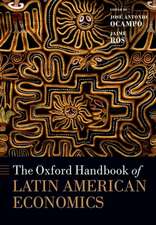A Theory of Interregional Dynamics: Models of Capital, Knowledge and Economic Structures: Lecture Notes in Economics and Mathematical Systems, cartea 523
Autor Wei-Bin Zhangen Limba Engleză Paperback – 27 noi 2002
Din seria Lecture Notes in Economics and Mathematical Systems
-
 Preț: 360.02 lei
Preț: 360.02 lei -
 Preț: 383.93 lei
Preț: 383.93 lei - 15%
 Preț: 693.39 lei
Preț: 693.39 lei -
 Preț: 384.09 lei
Preț: 384.09 lei -
 Preț: 380.07 lei
Preț: 380.07 lei -
 Preț: 446.26 lei
Preț: 446.26 lei -
 Preț: 497.37 lei
Preț: 497.37 lei -
 Preț: 380.84 lei
Preț: 380.84 lei -
 Preț: 384.86 lei
Preț: 384.86 lei -
 Preț: 378.34 lei
Preț: 378.34 lei -
 Preț: 399.67 lei
Preț: 399.67 lei - 20%
 Preț: 360.93 lei
Preț: 360.93 lei - 15%
 Preț: 643.16 lei
Preț: 643.16 lei -
 Preț: 379.09 lei
Preț: 379.09 lei -
 Preț: 404.76 lei
Preț: 404.76 lei -
 Preț: 385.62 lei
Preț: 385.62 lei - 15%
 Preț: 644.49 lei
Preț: 644.49 lei -
 Preț: 379.09 lei
Preț: 379.09 lei -
 Preț: 345.50 lei
Preț: 345.50 lei -
 Preț: 425.80 lei
Preț: 425.80 lei -
 Preț: 378.34 lei
Preț: 378.34 lei - 18%
 Preț: 775.65 lei
Preț: 775.65 lei -
 Preț: 392.60 lei
Preț: 392.60 lei -
 Preț: 401.61 lei
Preț: 401.61 lei - 15%
 Preț: 646.43 lei
Preț: 646.43 lei -
 Preț: 382.18 lei
Preț: 382.18 lei -
 Preț: 378.34 lei
Preț: 378.34 lei - 15%
 Preț: 637.59 lei
Preț: 637.59 lei - 15%
 Preț: 647.27 lei
Preț: 647.27 lei -
 Preț: 377.73 lei
Preț: 377.73 lei -
 Preț: 447.84 lei
Preț: 447.84 lei - 15%
 Preț: 644.49 lei
Preț: 644.49 lei -
 Preț: 386.00 lei
Preț: 386.00 lei - 15%
 Preț: 654.43 lei
Preț: 654.43 lei -
 Preț: 415.02 lei
Preț: 415.02 lei -
 Preț: 411.54 lei
Preț: 411.54 lei -
 Preț: 398.92 lei
Preț: 398.92 lei -
 Preț: 398.92 lei
Preț: 398.92 lei -
 Preț: 392.75 lei
Preț: 392.75 lei - 15%
 Preț: 635.47 lei
Preț: 635.47 lei - 20%
 Preț: 653.56 lei
Preț: 653.56 lei -
 Preț: 379.86 lei
Preț: 379.86 lei -
 Preț: 495.46 lei
Preț: 495.46 lei -
 Preț: 447.99 lei
Preț: 447.99 lei -
 Preț: 378.71 lei
Preț: 378.71 lei - 15%
 Preț: 637.13 lei
Preț: 637.13 lei -
 Preț: 385.84 lei
Preț: 385.84 lei -
 Preț: 378.54 lei
Preț: 378.54 lei - 15%
 Preț: 666.55 lei
Preț: 666.55 lei
Preț: 385.62 lei
Nou
Puncte Express: 578
Preț estimativ în valută:
73.79€ • 78.91$ • 61.52£
73.79€ • 78.91$ • 61.52£
Carte tipărită la comandă
Livrare economică 17 aprilie-01 mai
Preluare comenzi: 021 569.72.76
Specificații
ISBN-13: 9783540443063
ISBN-10: 3540443061
Pagini: 248
Ilustrații: XII, 232 p. 18 illus.
Dimensiuni: 155 x 235 x 13 mm
Greutate: 0.36 kg
Ediția:Softcover reprint of the original 1st ed. 2003
Editura: Springer Berlin, Heidelberg
Colecția Springer
Seria Lecture Notes in Economics and Mathematical Systems
Locul publicării:Berlin, Heidelberg, Germany
ISBN-10: 3540443061
Pagini: 248
Ilustrații: XII, 232 p. 18 illus.
Dimensiuni: 155 x 235 x 13 mm
Greutate: 0.36 kg
Ediția:Softcover reprint of the original 1st ed. 2003
Editura: Springer Berlin, Heidelberg
Colecția Springer
Seria Lecture Notes in Economics and Mathematical Systems
Locul publicării:Berlin, Heidelberg, Germany
Public țintă
ResearchCuprins
1 Introduction.- 2 Regional Growth with Productivity and Amenity Differentials.- 2.1 Regional Growth with Differences.- 2.2 Equal Propensities to Consume and to Hold Wealth.- 2.3 Changes in Region 1’s Working Efficiency.- 2.4 Changes in Region 2’s Amenity Level.- 2.5 On Regional Dynamics.- 3 Regional Growth with Endogenous Time Distribution.- 3.1 Growth with Regional Time Values.- 3.2 The Equilibrium Structure with Identical Propensities.- 3.3 The Working Efficiency and the Equilibrium Structure.- 3.4 The Regional Amenity and the Equilibrium Structure.- 3.5 Concluding Remarks.- Regional Sexual Division of Labor and Economic Growth.- 4.1 Regional Growth with Sexual Division of Labor.- 4.2 Equilibrium Structure of Regional Competition.- 4.3 Regional Amenity and the Equilibrium Structure.- 4.4 On Complex of Sexual Division of Labor and Consumption.- A Two-group Regional Growth Model.- 5.1 The Regional model with Multiple Groups.- 5.2 The Equilibrium Regional Structure.- 5.3 On Regional Dynamics with Multiple Groups.- 6 Urban and Rural Equilibrium Structures.- 6.1 The Economic Structure with Urban and Rural Areas.- 6.2 The Spatial Equilibrium Structure.- 6.3 City I’s Amenity and the Economic Structure.- 6.4 On Spatial Economic Structure.- 7 Regional Economic Equilibrium with two Groups.- 7.1 The Agricultural Economy with two Groups.- 7.2 The Regional Economic Equilibrium Structure.- 7.3 The Farmers and the Economic Structure.- 7.4 The Amenity of Landlord Class and Economic Structure.- 7.5 On Classes and Regional Economic Structure.- 8 Regional Growth with Economic Structure.- 8.1 Regional Growth with Structural Change.- 8.2 The Regional Equilibrium Structure.- 8.3 The Regional Amenity and the Economic Structure.- 8.4 The Propensity to Hold Wealth and the EconomicStructure.- 8.5 On Regional Growth and Structural Change.- 9 A Two-region Growth Model with Capital and Knowledge.- 9.1 Regional Growth with Endogenous Knowledge.- 9.2 Knowledge and the Equilibrium Structure.- 9.3 The Impact of Changes in some Parameters.- 9.4 On Knowledge and Regional Development.- 10 Regional Economic Structure with Endogenous Knowledge.- 10.1 The Dynamics of Regional Economic Structure.- 10.2 The Equilibria Structure and Stability.- 10.3 The Creativity and the Regional Economic Structure.- 10.4 Regional Dynamics with Knowledge.- 11 Regional Growth with Universities.- 11.1 The Regional Model with Universities.- 11.2 The Regional Equilibrium with Universities.- 11.3 The Education Policy and the Regional Structure.- 11.4 The Amenity Level and the Regional Structure.- 11.5 On Regional Dynamics with Universities.- 12 Regional Dynamics in an Isolated State.- 12.1 The General Model of the Isolated State.- 12.2 The Temporary Spatial Equilibrium.- 12.3 The Dynamics of Capital and Knowledge.- 12.4 The Population and the Spatial Structure.- 12.5 On Complexity of Economic Geography.- 13 Further Issues on Interregional Economics.- Name Index.







